The U.S. Department of Energy (DOE) and the National Renewable Energy Laboratory (NREL) are launching a new user facility for testing utility-scale renewable energy grid integration.
The Energy Systems Integration Facility (ESIF) in Golden, Colo., already has its first industry partner, Advanced Energy Industries, whose aim is to build better performing solar power inverters. The US $135 million facility will test how technologies such as solar modules, wind turbines, electric vehicles, and smart appliances interact with each other and the grid. Wind and solar, for instance, can wreak havoc on the electrical grid because of their intermittency. The center should help accelerate the adoption of smart grid technologies across the grid, from generation and transmission, down to individual buildings.
“This new facility will allow for an even stronger partnership with manufacturers, utilities and researchers to help integrate more clean, renewable energy into a smarter, more reliable and more resilient power grid,” Energy Secretary Ernest Moniz said in a statement.
ESIF (pronounced ē-sif), which was four years in the making, has more than 15 labs, plus outdoor test beds that will allow companies and researchers to test products at real grid load levels. The labs cover technologies in four areas: electricity, thermal systems, fuel cell and electrochemical research and data analysis, and visualization. The latter includes a high-performance data center designed to be one of the most energy efficient in the world, with a power usage effectiveness of 1.06 or better. The data center will allow researchers to do large-scale modeling and simulation.
Advanced Energy Industries worked with the DOE on the Solar Energy Grid Integration Systems (SEGIS) project, which is aimed at bringing solar power more seamlessly onto the grid. Advanced Energy’s solar inverter allows for two-way power flows and utility communications at a lower levelized cost of energy than some other inverters.
Communicating with inverters will be increasingly important as solar penetration in the United States increases. In Germany, where there is far more solar PV, inverters are already required to help minimize negative effects on the grid by providing functions such as power ramping.
The inverter manufacturer will take advantage of ESIF’s megawatt-scale power-in-the-loop system; it can simulate different grid conditions, which will allow Advanced Energy to fine-tune the performance of its inverters and drive costs down further.
“ESIF will do something different. It will fill research gaps and provide a national focal point for systems-integration R&D,” Robert Shapard, chairman of the GridWise Alliance, a coalition of smart grid advocates, said in a statement. “ESIF will be one of a few facilities in the country capable of providing for the fully integrated field-testing of hardware and software technologies, enabling advanced visualization and simulation, establishing a virtual utility operations platform, and providing smart grid interoperability testing and validation.”
Photo Credit: Air Force/Science Faction/Corbis



